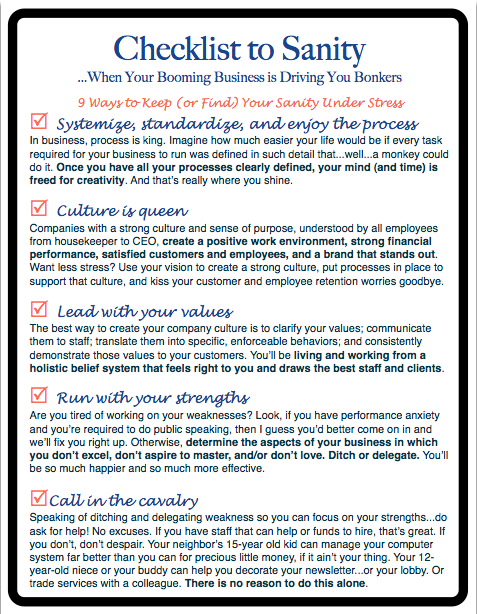How would you like to encourage and extract the very best from every employee while simultaneously improving the quality and consistency of your product… all while streamlining your processes and delighting your customers to boot? Introducing a few tools into your business management practices can turn your business into the veritable lean & mean machine of your dreams! I’ll introduce you to these tools in todays post and point you toward next steps in development. Let’s get started!
The Continuous Improvement Cycle: What is it and Why Should I care?
To some degree, the name says it all: Every business owner’s ideal is a business that is continuously improving – preferably with ease, like a well-oiled machine. This doesn’t happen by accident. It requires that a culture of excellence is established, communicated, and adopted by all stakeholders so that it infiltrates all areas of your business. Obviously, this is important to the longterm success (survival) of your business, so read on to learn about tools to generate the CIC.
We all know that communication is key. Key to what? Well, IMHO, it’s the key to pretty much everything happy and good in life. But let’s limit ourselves to the business world today, shall we? Simply put, awareness of attitudes, ideas, concerns, and engagement of your employees is critical to sustained business success. Anything that improves your ability to communicate (send and receive information accurately) with your employees is a tool you can use. Communication is the key to sustainability, especially where your employees are concerned.
So, how to get the information you need and what to do with it to live the dream…
Getting the information you need: The Employee Survey
Does the idea of an employee survey, cause a shudder? There’s a strategy that will make the process easier, and it starts with the Company-Wide Survey tool.
The most productive and loyal employees are those who feel comfortable speaking up and contributing. The CWS has the potential to reveal all the company, product, process, and customer issues of your business in one fell swoop. You can use the “Employee Survey Template” that provides the traditional SWOT (Strengths, Weaknesses, Opportunities, Threats) format. Your employees are asked to identify opportunities for increasing revenues, decreasing costs, improving management/leadership, and resolving a myriad of possibly unexamined problems. Alternatively, you can conduct face-to-face employee interviews, using the same SWOT approach.
If the whole idea makes you shudder a bit too much, have a business coach come in and interview all your employees for you. It’s likely to produce the most honest results, which can then be consolidated (and softened, if necessary) for your perusal.
Analyzing the Information You’ve Mined
The Analysis Worksheet can help you coordinate all the gathered information and produce meaningful priorities and feedback. The wealth of information you can gather in this manner can’t be overstated. Through the analysis, you will detect problems small and large, consistently reported or segmented. An added bonus is the side effect of sorting the wheat from the chaff. Engaged and committed employees will respond quite differently than will those who aren’t truly invested, providing valuable insight into the management needs of each individual.
So, now what?
Putting the Information to Use
Close your eyes and beam back for a moment to the mad men era. Picture a standard large business phone bank with a switchboard operator controlling and directing calls appropriately. Now, translate that process into the present day. Imagine having a switchboard operator to whom all employees report ideas, suggestions, customer complaints, and any other issues. The operator assigns the issue to the appropriate process team and maintains a log of issues and key information. This could include open and close dates, reporter, assigned process team, resolution, and financial impact. Imagine this information, all in one place – the switchboard – available to you at all times so that you can hold the right employees accountable and, just as important, give credit where credit is due. Sounds fantastic, doesn’t it? Well, here’s the Switchboard Communication Log that will help you get the job done.
All told, using just these few tools, you can create a continuous improvement machine. Employee notices a problem and reports it to the Switchboard Operator. The operator assigns the problem to the appropriate process team. The process team creates a project to address the problem. Once resolved, changes are communicated to all affected employees. And all along the way, you know what the problem is, who is responsible for resolving it, the status, and finally the resolution. And throughout this, you’re at the helm, stepping in to coordinate efforts when and if necessary. The best part? You’re employees are engaged, utilized, valued, appreciated and, therefore, fully invested. Now you’re cooking with gas!

FREE 9-point 'Checklist for Sanity' | Manage your business. Have a life.
We promise to never sell, rent, trade, or share your e-mail with any other organization.
* All fields required








